Anadama Bread Recipe: A New England Classic is made with flour, cornmeal, yeast, and molasses. There is a lovely sweetness from the combination of molasses and cornmeal. The scent of the bread while it bakes is just incredible!
If you like this recipe you might like my Apricot Summer Bread or my Ciabata Bread.
This article contains affiliate links which supports us at no extra cost to you.
Jump To
- 💖Why you'll love this recipe
- Why Is It Called Anadama Bread?
- What is the history of anadama bread?
- 🛒 Ingredients for Anadama Bread
- 🍽️ How to Make Anadama Bread
- What Does Anadama Bread Taste Like?
- 🫙 Leftover and Storing
- 📃 Substitutions & Variations
- ☑️ Pro Tips for Baking Anadama Bread
- ❓ FAQ'S
- Some other bread recipes you'll love:
- 📖 Recipe
- Anadama Bread
💖Why you'll love this recipe
- Wholesome Ingredients: Made with pantry staples like cornmeal, whole wheat flour, and molasses.
- Versatile: Perfect as a sweet bread for breakfast or as a side with soups and stews.
- Historical Connection: A recipe rooted in New England tradition that’s been enjoyed for generations.
Originally published on September 1, 2015 and slightly updated on February 8, 2025.
This Anadama bread recipe is a New England classic, combining the earthy flavors of cornmeal, the subtle sweetness of molasses, and the satisfying chew of yeast bread. Whether you’re a seasoned baker or a beginner, this old-fashioned recipe is perfect for cozy weekends at home. The scent of fresh bread baking, with its nostalgic molasses aroma, is worth the effort.
This Anadama Bread is a really great bread I shared a while back with my monthly baking project #TwelveLoaves. You could make it with many ingredients you may have right in your pantry. I promise you that the process of making the bread is comforting and the scent of it while baking is absolutely incredible!
We are back with another month of bread baking inspiration! I know you may be wondering what is an anadama bread!! As is typical with each month, I wasn't sure which bread I wanted to share. I remembered my gorgeous March issue of Bon Appetit had an Anadama bread recipe chock full of seeds...so that was the bread I would share!
You may be wondering what in the world...ANADAMA? I know I was when I first heard it's name!! The bread originates in New England and it is usually made with whole wheat flour, cornmeal, molasses and sometimes even rye flour. I found the info on this cool site by Joyce White who is an Annapolis based food historian:
Why Is It Called Anadama Bread?
The origins of Anadama bread trace back to New England in the 19th century. Legend has it that a frustrated husband created the bread by combining leftover cornmeal mush with flour, yeast, and molasses, exclaiming, "Anna, damn her!" This whimsical story gives the bread its memorable name.
What is the history of anadama bread?
- Supposedly, the bread was created sometime before 1850 by either a fisherman or a Finnish stonecutter from the Rockport or Gloucester, Massachusetts areas. The legend claims that a disgruntled husband lashed out at his wife, Anna, for serving him boring cornmeal mush one too many times. In a fit of exasperation, he yelled, "Anna, damn her!", as he added flour, yeast, and molasses to the cornmeal to make something new and different, a cornmeal-based risen bread.
- Interestingly, a 1936 recipe for the bread in The New England Cook Book, 300 Fine Od Recipes, compiled and edited by Kate Morrow by the Culinary Arts Press has a recipe called Amadama Bread, with an M instead of an N. It is listed this way in both the index and the recipe.
- What is known is that according to the records of the U.S. Patent and Trademark Office, Anadama bread was introduced as a brand of bread in 1850, and the first use in commerce was July 1, 1876 for Anadama Mixes, Incorporated. Around the turn of the 20th century, Baker Knowlton of Rockport, made the bread and sold his version of it in horse-drawn carts. Additionally, other 20th century bakeries made and sold Anadama bread throughout the New England region."
🛒 Ingredients for Anadama Bread
- 1 cup warm water (110°F for activating yeast)
- 2 ¼ tsp active dry yeast
- 1 tsp sugar
- 2 tbsp butter (vegan butter works for a plant-based option)
- ¼ cup molasses
- 1 tsp sea salt
- 1 cup cornmeal
- 2 cups all-purpose flour
- 1 cup whole wheat flour
- Optional: Poppy seeds, chia seeds, or flax seeds for added texture and flavor
🍽️ How to Make Anadama Bread
Here is how to make this bread (the full recipe is below!):
- Step 1: Activate the Yeast: In a large mixing bowl, dissolve the sugar in the warm water. Sprinkle the yeast over the water and let sit for 5–10 minutes until frothy.
- Step 2: Mix the Ingredients: Stir in the butter, molasses, salt, and cornmeal. Gradually add the wheat flour and all-purpose flour, mixing until a soft dough forms.
- Step 3: Knead the Dough: Transfer the dough to a lightly floured surface and knead for 8–10 minutes until smooth and elastic.
- First Rise: Place the dough in a greased bowl, cover with a damp towel, and let rise in a warm place for 1–2 hours, or until doubled in size.
- Shape the Loaf: Punch down the dough and shape it into a loaf. Place it in a greased Dutch oven or loaf pan.
- Second Rise: Let the dough rise for another 30–40 minutes until it puffs up.
- Bake: Preheat the oven to 375°F. Bake the bread for 30–35 minutes, or until golden brown. Cool on a wire rack before slicing.
📃 NOTE: Recipe card with detailed instructions are below! Print it out for later!
What Does Anadama Bread Taste Like?
This New England bread has a mildly sweet, nutty flavor from the molasses and cornmeal. Its texture is soft yet hearty, making it ideal for toast, sandwiches, or as an accompaniment to hearty stews.
🫙 Leftover and Storing
Proper storage is key to keeping your Anadama bread fresh and delicious for as long as possible. Here are some tips:
- Room Temperature: Store the cooled bread in an airtight container or wrap it tightly in plastic wrap. It will stay fresh at room temperature for up to 3 days. Avoid storing bread in the refrigerator as it can dry out.
- Freezer Storage: For longer storage, slice the bread and wrap each piece individually in plastic wrap. Place the wrapped slices in a freezer-safe bag and freeze for up to 3 months. This allows you to thaw only what you need.
- Thawing: To enjoy frozen bread, let the slices thaw at room temperature for about 30 minutes. Alternatively, reheat the slices in a toaster or oven for a freshly baked taste.
- Reheating Whole Loaves: If you’ve frozen a whole loaf, let it thaw overnight in the refrigerator, then warm it in the oven at 300°F for 10–15 minutes.
📃 Substitutions & Variations
- Molasses Substitutes: Use maple syrup or honey if you don’t have molasses.
- Rye Flour: Substitute a portion of the wheat flour for rye flour for a deeper flavor.
- Sweet Additions: Add dried fruits like raisins or cranberries for a sweeter loaf.
☑️ Pro Tips for Baking Anadama Bread
- Use Warm Water: Ensure the water is between 105°F and 115°F to properly activate the yeast.
- Let It Rise: Be patient with the rising process to achieve a light, airy texture.
- Add Seeds: Sprinkle the dough with flax, chia, or poppy seeds for added crunch and nutrition.
- Store Properly: Keep the bread in an airtight container to maintain freshness for up to 3 days. For longer storage, freeze slices and thaw as needed.
❓ FAQ'S
Anadama bread provides fiber from whole wheat flour and cornmeal, but its molasses content adds natural sweetness. It’s a healthier option compared to enriched breads.
Pair it with hearty soups, stews, or chowders. It’s also delicious with butter, jam, or honey for breakfast.
A slice of Anadama bread typically contains 20–25 grams of carbohydrates, depending on the recipe and portion size.
Yes, substitute the all-purpose and wheat flours with a gluten-free baking blend. Keep in mind the texture will differ slightly.
This bread originated in New England, where it was popularized by bakers in Massachusetts in the late 1800s. Its unique name and flavor make it a standout among traditional yeast breads.
Absolutely! Combine the ingredients in your bread machine, following the manufacturer’s instructions for a molasses bread or basic bread cycle.
While Anadama bread is rooted in New England tradition, other exotic breads include Ethiopian injera, German pumpernickel, and Japanese milk bread.
The original recipe for anadama bread does not have seeds in it. I used what I happened to have on hand in my pantry. When I found this recipe, I was so excited because I had so many seeds on hand to use. You could totally mix this up with whatever seeds you would like. Here is what I used for the bread:
white sesame seeds, ground flax seeds, ground chia seeds, poppy seeds (I LOVE baking with poppy seeds).
Some other bread recipes you'll love:
Did you make this? Please RATE THE RECIPE below:)
Please Subscribe and give a follow on Instagram, Facebook, Pinterest, and TikTok xx
📖 Recipe
Anadama Bread
Ingredients
- ½ cup very warm water + more for the dough
- 1 Tbsp or pkg. of active dry yeast
- ½ tsp granulated sugar
- 2 ½ cups all-purpose flour
- 1 cup fine ground cornmeal
- 1 ¼ tsp. Kosher salt
- ¼ cup mild molasses
- 2 Tbsp softened butter or vegan butter stick
- 2 Tbsp ground flax seeds optional
- 2 Tbsp ground chia seeds optional
- 2 tsp. Poppy seeds optional
- 2 tsp white sesame seeds optional
Instructions
- Activate the Yeast: In a small bowl, add the warm water and sprinkle the yeast on top and add the sugar. Gently give it a stir and let it proof (5-10 minutes until foamy).
- Mix the Ingredients: In a stand mixer, using the dough hook, mix all the ingredients together. Add the proofed yeast and about another 1/2 cup of water, adding the water slowly just until the dough comes together. *You could also do this by hand in a large bowl using a wooden spoon to stir all the ingredients together.
- Knead the Dough: When dough is ready, turn mixer off and remove the the dough hook. Turn the dough out onto a bread board (or a clean counter) and knead until smooth, 8-10 minutes.
- First Rise: Brush another large bowl with 2 teaspoons of a mild flavored oil (coconut oil would work great for this recipe).
- Form dough: Form the dough into a ball and place into the oiled bowl (when I put the dough in the bowl I swish the dough around the bottom of the bowl and then flip it over so all of the dough is covered in a light film of oil).
- Cover: Cover with a towel or plastic wrap and let it rise at room temperature until doubled in size (about 1-2 hours).
- Shape the Loaf: When dough has doubled in size, grease a loaf pan (you could use a vegan butter stick to keep this vegan/dairy-free, or use butter. I like to line my loaf pan with parchment paper and spray with baking spray). Remove the dough after the rising and form into a loaf (8" x 4" x 4").
- Second Rise: Place into the prepped loaf pan, cover with a towel, and allow it to rise another 45 minutes.
- Heat oven: Just before the dough is ready, preheat the oven to 375F-degrees. Place the loaf pan into the oven and bake for 40-45 minutes, or until a thermometer reads 180F-degrees internally.
- Bake: Remove from the oven and allow to sit on a rack for 10 minutes before turning it out of the pan. Allow to cool completely before cutting into it.
Nutrition Disclaimer
Please keep in mind that the nutritional information presented below is an approximation and may vary depending on the exact ingredients used.


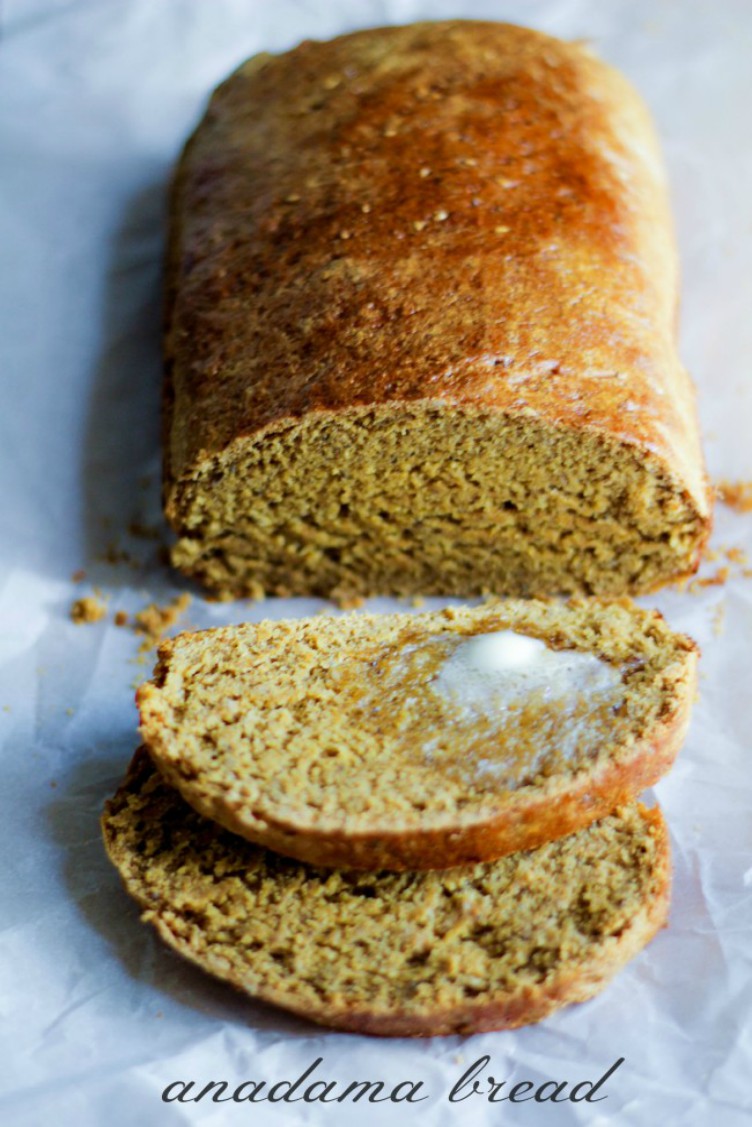
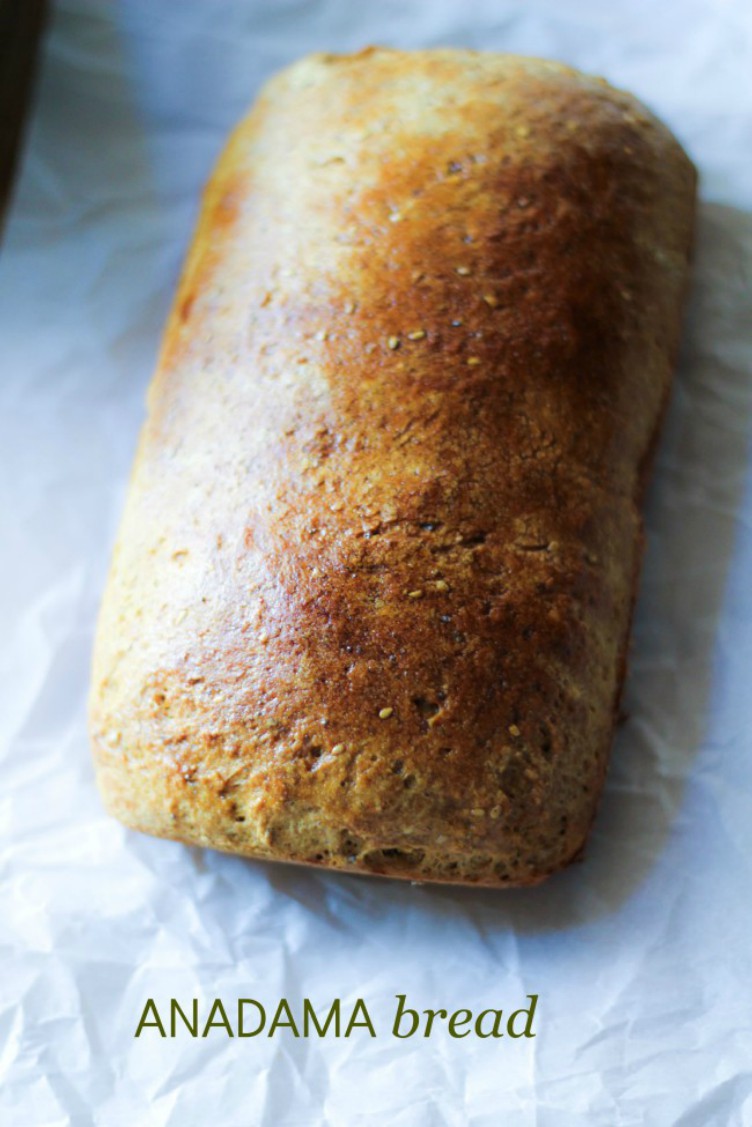
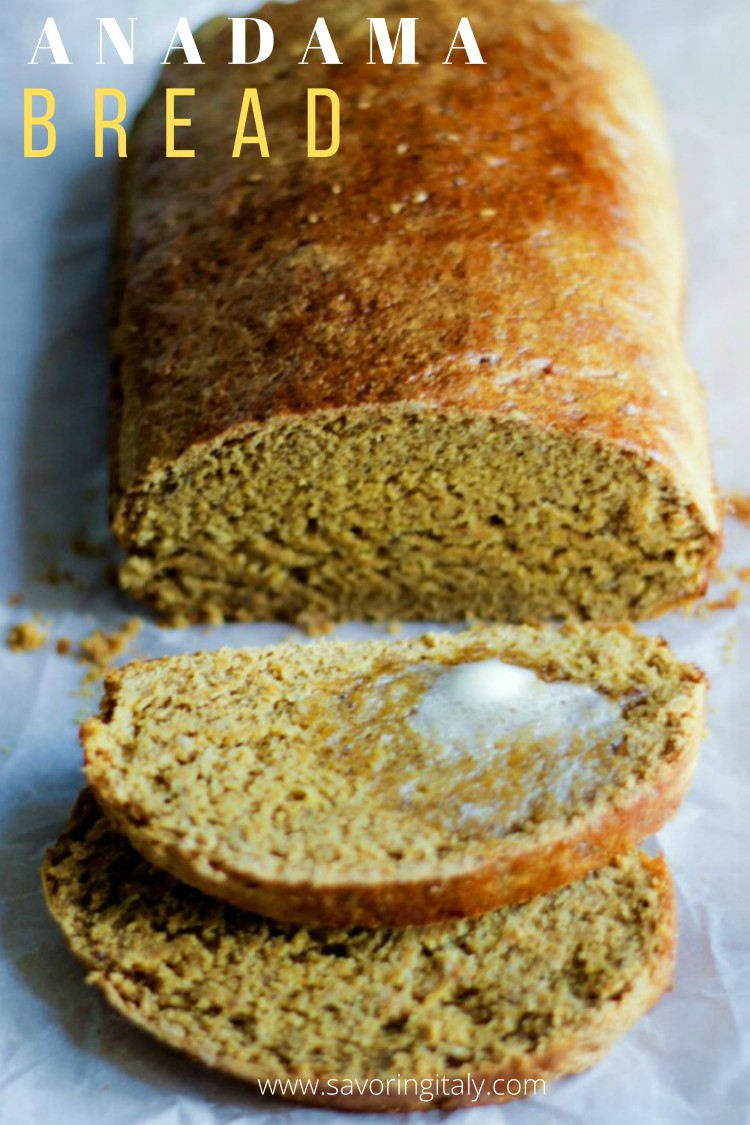
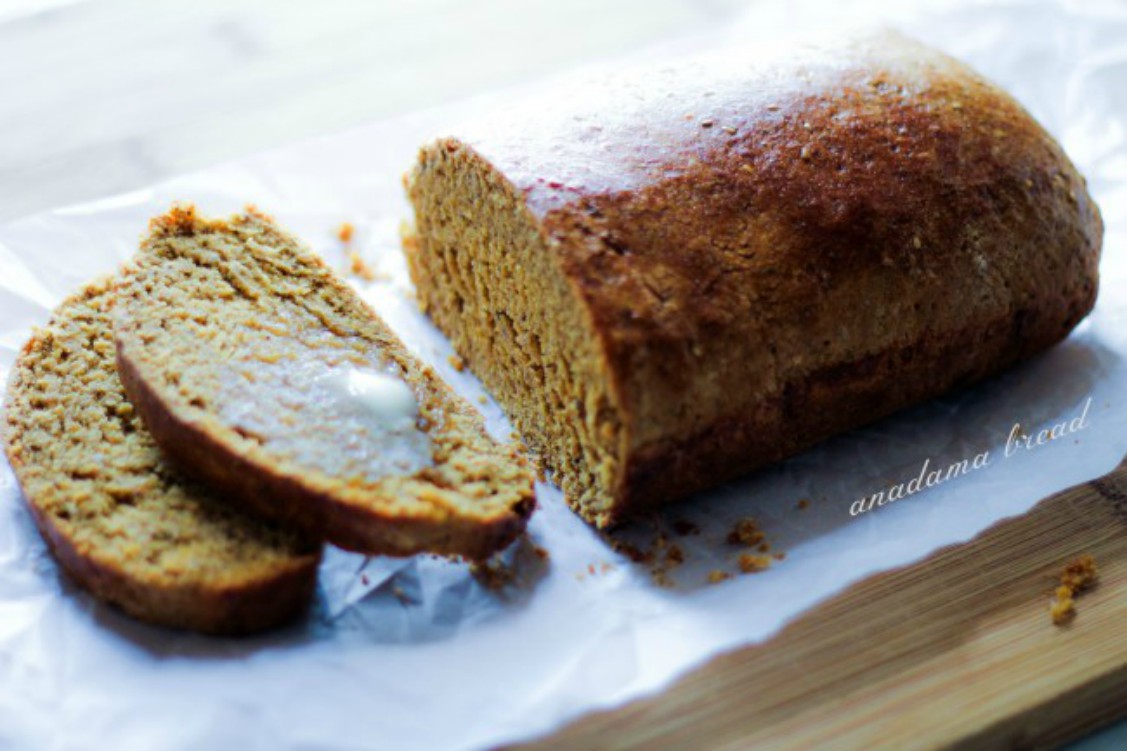
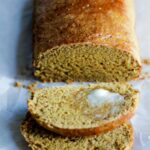

Chris says
I grew up in Springfield, and my grandmother used to bake this bread! Brings so many memories! Delicious!
Lora says
Hi Chris-Thank you for taking the time to write me. Very happy you enjoy the anadama bread!